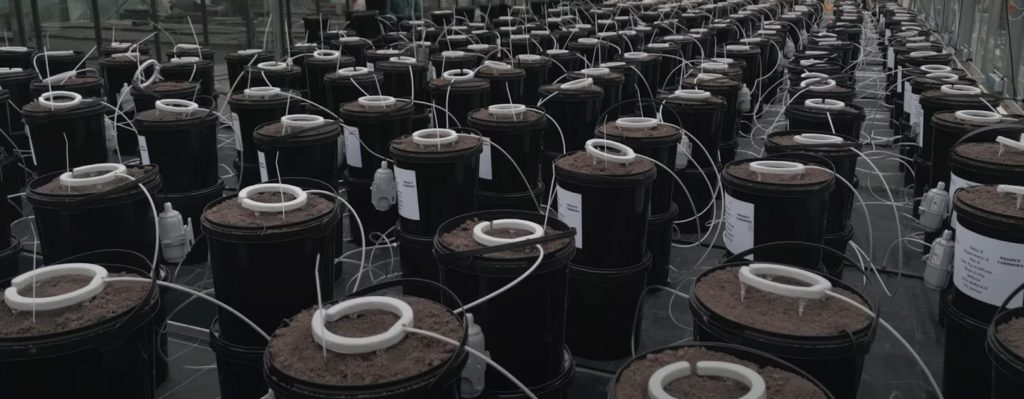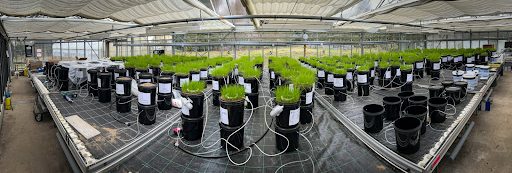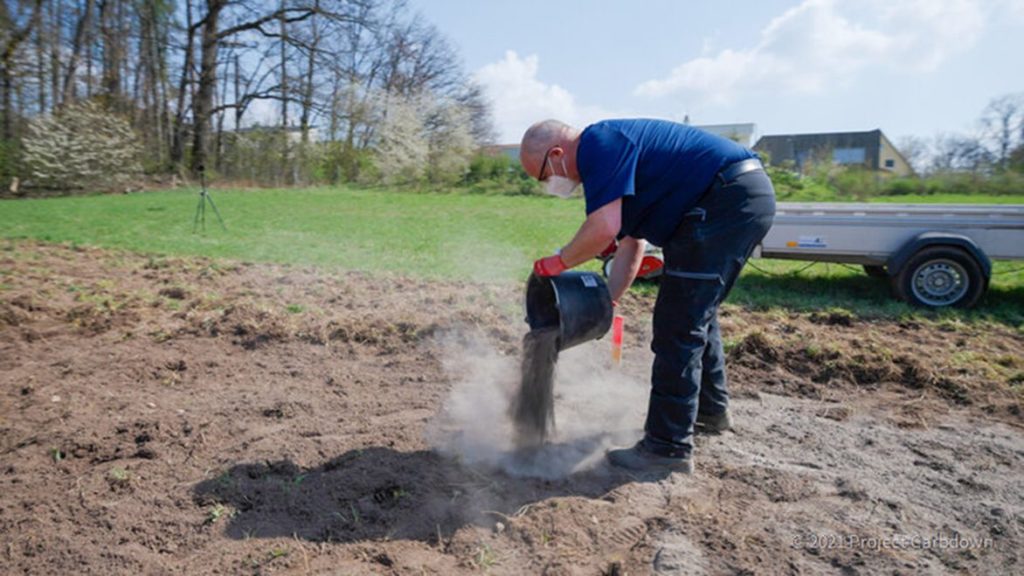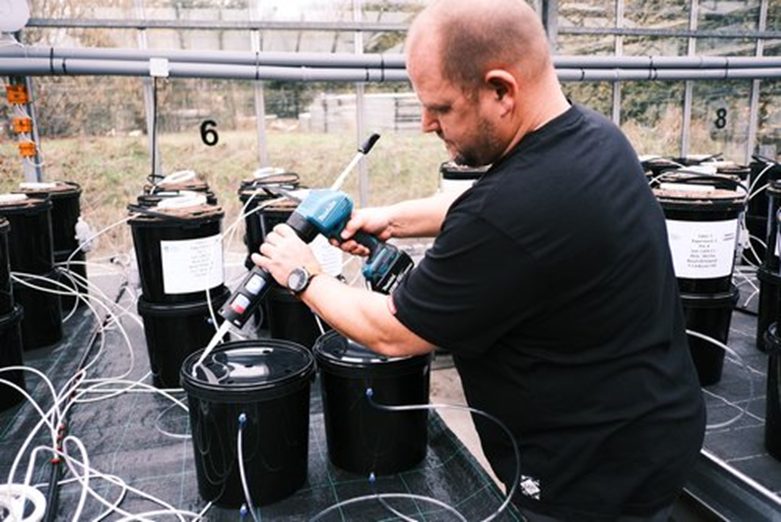Carbon Drawdown Initiative Advocates New Recipe for ERW Research
In a time of increasing uncertainty about the future, unprecedented fossil fuel consumption, and the frustrating stagnation of deployable green energies, it might seem difficult to imagine a positive future. But those at the Carbon Drawdown Initiative are self-proclaimed “optimists” who see the present period as an opportunity to learn as much as we can and stock our green arsenals for when the time comes that our society is ready for collective change. The Carbon Drawdown Initiative focuses on supporting research, negative emission technology, and public/political work to establish frameworks that can facilitate new technologies as they are developed. The organization also performs scientific experiments that measure carbon dioxide (CO2) removal from enhanced rock weathering (ERW).
On their blog on enhanced weathering, the direct relationship between atmospheric carbon dioxide content and global temperatures means that warming will continue even if emissions are reduced. To avoid catastrophic effects of global warming in the coming decades, we must begin actively capturing and storing carbon dioxide at a massive scale. ERW has huge potential for scalability, along with relatively low cost, permanent storage capacity, and acceptable socio-economic and ecological impacts. That’s why the Carbon Drawdown Initiative believes it is the right approach to attack the climate crisis head-on.
However, if we aim to apply this solution on a large scale, academic evidence alone is not enough: key questions surrounding the practical implications of using crushed rock to sequester carbon need to be answered with projects that simulate real-world conditions. To gather concrete data that supports the utility of ERW, Dirk Paessler, Ralf Steffens, and scientists from across Europe are working together to determine how to monitor, verify, and report CO2 capture from ERW methods.
From field trials to mesocosm
To further this mission, in 2021 the Carbon Drawdown Initiative launched Project Carbdown, an ERW field trial that sought to measure the quantity of carbon sequestered with the addition of 4 kg/m² of basaltic rock dust to crop fields. However, considering a slow natural weathering rate of about 1% per year, it was realized by year 1 that finding the small amount of weathering in an uncontrolled field environment was not feasible. In other words, the signal (weathering products) was too weak to be distinguished from the noise (natural, highly variable soil conditions).
Because of these challenges, they concluded that an experiment between field and lab scale would be a better way to measure the weathering process under different controlled conditions. This led to the inception of their new mesocosm scale Carbdown Greenhouse Experiment, which seeks to measure and compare weathering and carbon sequestration rates within miniaturized, climatically controlled environments. Key directives of the research are:
- To determine the quantity and timeframe in which ERW can remove CO2,
- To easily compare the effects of different treatments across a single group of samples, and
- To collect more data which can be used to train and test future modeling simulations.
However, Carbon Drawdown Initiative is not alone in their interest in the science of ERW. Over the past few years, there has been an explosion of research on enhanced weathering, with hundreds of journal articles published on the subject. Many of these studies provide new experimental and field data quantifying the effectiveness of ERW as a global carbon dioxide removal (CDR) strategy. The relatively large number of studies from research groups all over the world is encouraging and speaks to the great promise of ERW. However, the drawback of this relatively sudden increase in enhanced rock weathering research is that groups often use different experimental approaches, methods, and assumptions. This can make it challenging to compare datasets and results between research groups.
To address this potential problem Carbon Drawdown Initiative has pitched their own successful experimental approach as a “recipe” that can be followed by other researchers with the hope of standardizing ERW research. On their blog they encourage ERW researchers to undertake carefully controlled greenhouse “pot” tests when investigating new soil/rock dust combinations. The article lays out their experimental setup, describes the reasoning for their design, and provides a shopping list of all the materials and sensors needed to successfully monitor ERW processes. The stated goal of the article is to enable other research teams to build on the Carbon Drawdown Initiative’s approach, while producing standardized datasets that can be readily compared and used to train emerging ERW modeling tools.
It’s a call to action for ERW researchers to work together to create a coherent body of reproducible research that will facilitate scale-up, reduce uncertainties and help convince policymakers and the public that enhanced rock weathering is an environmentally safe and effective carbon dioxide removal method.
Speed First
The Carbon Drawdown Initiative’s experimental setup emphasizes “speed first!” as their prime directive. This refers to the speed of rock weathering in their experiments. They point out that the ERW research community doesn’t have time to wait for data from field experiments in which weathering rates can be slowed by seasonal and periodic decreases in temperature and moisture levels (two key variables that determine mineral weathering rates).
The Carbon Drawdown Initiative supports the use of field tests for demonstrating scale-up and rock weathering under natural conditions; however, they emphasize that greenhouse/pot experiments are essential because they allow researchers to accelerate rock weathering rates by maintaining elevated temperatures and moisture levels.
Greenhouse tests allow researchers to accurately monitor ERW processes in real time with strong signal-to-noise ratios. The primary “signal” is the amount of CO2 removed from soil pore spaces and converted to dissolved carbonate molecules by mineral weathering reactions. For the weathering rate “signal” to be clear in the experiments, it must be appreciably “louder” than the “noise” resulting from natural chemical and biological processes and measurement/sensor errors. Luckily, “noise” resulting from natural chemical and biological processes in controlled environments is less than in field conditions, and four replicas of each type of rock dust treatment help to constrain measurement and sensor errors.

Scientists working on the experiment believe that the signal will become louder as time passes and more water and rock dust flow through the system. They also predict that quick-weathering rocks such as dunite will create a signal more quickly than rocks that weather slowly. Gathering data about the strength of the signal and how fast it appears in the Carbdown greenhouse experiment will help bridge the gap between the established scientific knowledge about ERW and the practical applications for effectively scaling it into a global carbon drawdown strategy. As stated in the Carbon Drawdown Initiative blog article: “The goal is to create the fastest and strongest weathering signal that we can (while still having plant life/bioactivity in our pots – we even added worms) and use this to find/develop an actual measurement method. As soon as this has been found, we can move back to nature.” (A video explaining the experimental design and approach can be found here.)
Another significant advantage of greenhouse experiments is that they allow proper chemical mass balance. That is, researchers can track exactly where the elements released from rock weathering rock go over a given time interval. By analyzing the soils, plants, and soil leachates (i.e., water that passes through the soils and is collected in “underground” containers), they can determine the real-time transport and distribution of calcium, potassium, phosphorus, and other key nutrient elements within the soil-plant-water system. This is a challenge in field tests because of sampling difficulties.
The second directive or point of emphasis for Carbon Drawdown Initiative’s experimental approach is keeping material and labor costs low. They found that they could set up 250 pot experiments in just two days with the help of 25 people at a material cost of around $15 USD per pot. Each pot contains approximately 10 liters of soil, various types of rock dust amendments, and sensors that continuously measure soil moisture, electrical conductivity, pH, and soil CO2 levels.
Using their speed-first and cost-lowering directives, the Carbon Drawdown Initiative have constructed 300 assemblies of lysimeters (devices to measure solutions) with 80+ treatments to answer questions about changes in CO2 storage due to changes in several variables: rock dust types, particle sizes, application rates, and volumes of water.
The lysimeters were devised as three buckets stacked on top of each other, where the bottom bucket collects the percolated water (leachate), the middle bucket has holes drilled in the bottom and is layered with (from bottom to top) a root fleece, 3 cm of sand, 10 cm of untreated soil, and 15 cm of soil and rock dust mixture. Within the soil mixture, 20 worms of varying species were incorporated to mimic natural biological activity in the soil environment and further expedite the weathering process by promoting well aggregated, low bulk density soil, which air and water readily flow through. A teabag filled with 5 grams of the same rock dust type that is mixed into the soil of that bucket (either steel slag, basalt, or dunite) was also added to the container, which provides a way to directly analyze the effect of the treatment on weathering.
Based on the change of mass of the teabag from the original 5 grams, some observations can be made as to the efficiency of the treatment conditions. Sensors within the soil measure electrical conductivity and soil pH. On top of the soil, a perennial grass is grown. The top (removable) bucket has a gas sensor which measures CO2 flux over time.
Looking Forward
In discussing their experimental goals, the Carbon Drawdown Initiative identifies three major obstacles that must be overcome before ERW can be deployed as a large-scale carbon dioxide removal technology.
The first of these is the need for two or more independent and converging methods to measure how much CO2 is actually removed from the atmosphere over a given time interval. Quantifying the actual rate of CO2 drawdown for a particular ERW application is essential for carbon credit certification and CDR optimization.

The second obstacle has already been mentioned: the lack of standardization of field and laboratory experiments. Carbon Drawdown Initiative encourages ERW research groups to perform some of their tests using a common set of samples and monitoring methods to build confidence that independently produced datasets are comparable, measuring the same processes.
The third obstacle is the need for accurate computer models that are trained to calculate the amount of rock weathered and CO2 sequestered for a particular ERW application. Using computer models is inevitable for large-scale ERW projects involving thousands of hectares of crop and pasture land (which is what will be needed to make ERW a viable CDR technology). Collecting and analyzing regular soil and water samples from such large areas is simply not economically feasible.
Therefore, large, public datasets from carefully controlled experiments will be needed to train the computer models used to certify CO2 sequestration from ERW. This, again, points back to the need for cooperation and some degree of standardization among researchers.
The Carbon Drawdown Initiative’s open-access approach to research, their detailed experimental recipe, and their call for increased cooperation and standardization among researchers are indispensable for solving the technical obstacles discussed above. Their leadership is playing an essential role in legitimizing ERW as a globally-significant, nature-based methodology for fighting climate change.
Dyani Frye is an environmental scientist passionate about communicating science so that it can be accessible to all audiences. She graduated from California Polytechnic State University (2022) with a Master’s degree in Environmental Science and Management. Her thesis project investigated the use of an emergent spectroscopic technology, portable X-ray fluorescence, to predict physical and chemical properties of California soils. This research showed the viability of these predictive models across a broad geographic range. She believes that to preserve our most precious shared natural resources and achieve true sustainability, science must be paired with inclusive social initiatives and economic incentives. Through her writing at RTE, she hopes to use her science distillation skills to give others a better understanding of earth systems and how we can all positively impact the environment. In her free time, Dyani loves to identify flora and fungi during strolls through the woods, play chess, and read fantasy novels.
James Jerden is an environmental scientist and science writer focused on researching and promoting sustainable solutions to urgent environmental problems. He holds a Ph.D. in geochemistry from Virginia Tech and a Master’s degree in geology from Boston College. Over the past 20 years, James has worked as a research geochemist and science educator. He joined Remineralize the Earth because of their effective advocacy, research, and partnership projects that support sustainable solutions to urgent environmental issues such as soil degradation (food security), water pollution from chemical fertilizers (water security), deforestation, and climate change. As a science writer for RTE, his goal is to bring the science and promise of soil remineralization to a broad, non-technical audience. When not writing, he can be found at his drum set.
Support us on Patreon
Thank you for joining us today! Please become a member of RTE and support us on Patreon. Unlike many larger organizations, we work with a team of determined and passionate volunteers to get our message out. We aim to continue to increase the awareness of remineralization to initiate projects across the globe that remineralize soils, grow nutrient dense food, regenerate our forests’ and stabilize the climate – with your help! If you can, please support us on a monthly basis from just $2, rest assured that you are making a big impact every single month in support of our mission. Thank you!












Got something to say?